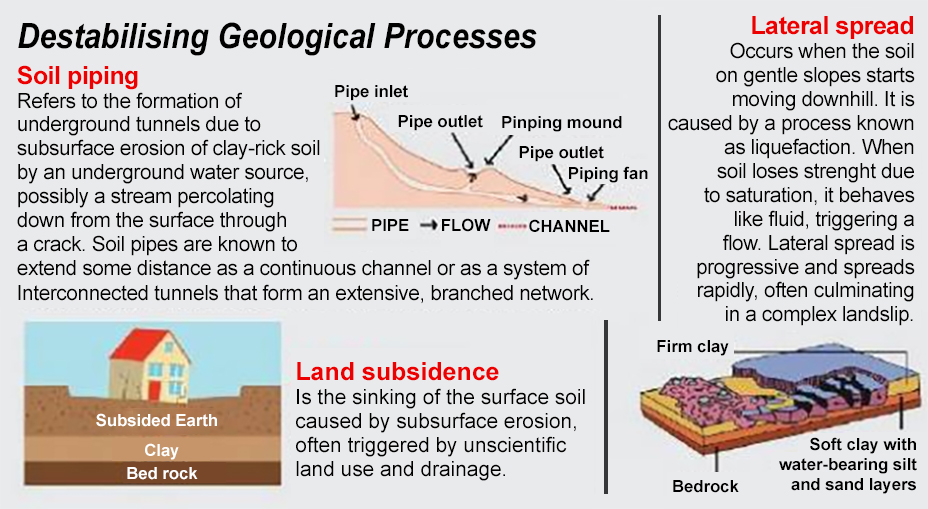Geography
Threat to Human Habitation in the Highlands of Kerala
- 14 Aug 2019
- 5 min read
Investigation of National Centre for Earth Science Studies (NCESS) scientists in Kerala, in the wake of the heavy rain and devastating floods in August 2018, had found that destabilising geological processes, coupled with extreme rainfall events and unscientific farming and construction activities, pose a serious threat to human habitation in the highlands of the state.
- During the investigation in landslide prone areas in Thrissur and Kannur districts of Kerala, the researchers found huge cracks across farmlands and dwellings.
- In the areas surveyed, most of the slopes were used for raising crops and farmers had blocked the natural drainage systems.
- Land subsidence, lateral spread and soil piping were an immediate threat to life and property in the uplands of the state.
- Heavy intense rainfall triggers slope failure in locations where lateral spread and soil piping have occurred.
- Any developmental activities like construction of roads and buildings in such vulnerable areas require remedial measures for slope stabilisation.
- The team apart from outlining the remedial steps also recommended the formation of a trained task force for the highlands to monitor ground signatures like hollows, cracks, and water spouts that often precede land subsidence, lateral spread and landslides.
- Based on the recommendations of the NCESS, the Union Ministry of Earth Sciences (MoES) has initiated steps to establish a network of landslip monitoring stations in the highlands.
- The units based on acoustic emission technology will also have an early warning mechanism to alert the local community.
Landslide
- A landslide is defined as the movement of a mass of rock, debris, or earth down a slope.
- Landslides are a type of "mass wasting", which denotes any down-slope movement of soil and rock under the direct influence of gravity.
- There are 5 main types of landslides:
- Falls are sudden movements of loads of soil, debris, and rock that break away from slopes and cliffs. They occur as a result of mechanical weathering, earthquakes, and force of gravity.
- Slides are a kind of mass movement whereby the sliding material breaks away from underlying stable material.
- Topple encompasses the forward spinning and movement of huge masses of rock, debris, and earth from a slope. It takes place around an axis near or at the bottom of the block of rock.
- Spread takes place on gentle terrains via lateral extension followed by tensile fractures.
- Flow landslide is categorized into earth flows, debris avalanche, debris flow, mudflows, and creep. The most prevalent occurring landslides are rock falls and debris flow.
- While landslides are considered naturally occurring disasters, human-induced changes in the environment have recently caused their upsurge.
- Natural Causes of Landslides are:
- Climatic changes
- Seismic activities
- Weathering (natural procedure of rock deterioration that leads to weak, landslide-susceptive materials)
- Erosion
- Volcanic eruptions
- Steeper slopes
- Human causes of landslides are:
- Mining activities
- Deforestation
National Centre for Earth Science Studies (NCESS)
- It was established in 1978 by Prof. C. Karunakaran.
- It operates by the Earth System Science Organization under the Ministry of Earth Sciences.
- It aims to understand the earth in its totality and gain knowledge on the interactive and competing processes that shape the earth, from its evolution to the present status of ever increasing demand for natural resources.
- NCESS fosters multidisciplinary research in emerging areas of solid earth science by utilizing the knowledge for earth science applications .
- It is situated at Thiruvananthapuram in Kerala.







